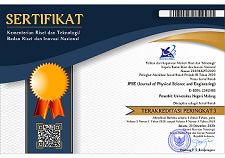Type of Mineral Deposits on Alteration Rocks using Petrography, X-Ray Fluorescence (XRF), and X-Ray Diffraction (XRD) Method in Geothermal Prospect in Tiouw Village, Maluku
Abstract
Indonesia is a country with abundant geothermal energy potential. One of the locations that have potential geothermal energy sources is Tiouw Village, Saparua, Central Maluku. This study was conducted on the types of mineral deposits using the petrographic method, X-Ray Diffraction (XRD), and X-Ray Fluorescence (XRF). Based on the results of petrographic analysis and XRD, rock samples 1, 2, and 3 of Tiouw include andesite igneous rocks with propylitic alteration type. While sample 4 is dacite igneous rock with argillic alteration type. Each rock sample has a mineral set of kaolinite, chlorite, quartz, cristobalite, epidote, and plagioclase. The XRF results showed the highest chemical composition of SiO2, followed by Al2O3 and K2O. This mineral content can indicate the subsurface temperature of the geothermal field in the range of 200–300 ºC with varying salinity, pH close to neutral, and low permeability. This interpreted that the type of mineral deposits in Tiouw Village was high sulfidation epithermal deposits.
Keywords
Full Text:
PDFReferences
D. Gentana et al., “Alterasi Hidrotermal Gunung Rendingan Berdasarkan Analisis Petrografi dan X-Ray Diffraction (XRD),” Buletin Sumber Daya Geologi, vol. 13, no. 3, pp. 177–198, 2018.
Rahmawati, S. Maryanto, and A. Susilo, “Identifikasi Sistem Panas Bumi Daerah Cangar, Jawa Timur, Menggunakan Metode Geomagnetotelurik,” J. Phys. Sci. Eng., vol. 2, no. 2, pp. 72–82, 2017.
S. Suryantoro et al., “Geothermal Deregulation and Energy Policy in Indonesia,” in Proc. World Geothermal Congress 2005, Atalya: International Geothermal Association, pp. 1–10, 2005.
Kasbani, “Sumber Daya Panas Bumi Indonesia: Status Penyelidikan, Potensi, dan Tipe Sistem Panas Bumi,” in Proc. Kolokium Pusat Sumber Daya Geologi, Bandung: Kementerian Energi dan Sumber Daya Mineral, pp. 1–11, 2009.
M. H. Dickson and M. Fanelli, What is Geothermal Energy?, Pisa: Istituto di Geoscienze e Georisorse, 2004.
A. A. R. Zohdy, L. B. A. Anderson, and L. J. Muffler, “Resistivity Self-Potential and Induced Polarization Surveys of A Vapor-Dominated Geothermal System,” Geophys., vol. 38, no. 6, pp. 1130–1144, 1973.
N. C. White and J. Hedenquist, “Epithermal Gold Deposits: Styles, Characteristics, and Exploration,” SEG Newslett., no. 23, pp. 1–13, 1995.
F. Goff and C. J. Janik, “Geothermal Systems,” in Encyclopedia of Volcanoes. H. Sigurdsson et al., Eds., Cambridge: Academic Press, pp. 817–834, 1999.
M. P. Hochstein and P. R. L. Browne, “Surface Manifestation of Geothermal Systems with Volcanic Heat Sources,” in Encyclopedia of Volcanoes. H. Sigurdsson et al., Eds., Cambridge: Academic Press, pp. 835–853, 1999.
S. C. Creasey, “Some Phase Relation in Hydrothermally Altered Rocks of Porphyry Copper Deposits,” Econ. Geol., vol. 54, no. 3, pp. 351–373, 1959.
A. M. Bateman, The Fomation of Mineral Deposits, New York: Wiley, 1951.
F. Pirajno, Hydrothermal Mineral Deposits, Principles and Fundamental Concepts for the Exploration Geologist, Heidelberg: Springer, 1992.
V. Yosana et al., “Zona Alterasi Hidrotermal Pada Sumur Penelitian “VY 2”, Lapangan Kamojang, Jawa Barat, Indonesia,” Padjadjaran Geosci. J., vol. 1, no. 2, pp 164–171, 2017.
G. J. Corbett and T. M. Leach, Southwest Pacific Rim Gold-Copper Systems: Structure, Alteration, and Mineralization, Colorado: Society of Economic Geologist, 1998.
R. H. Silitoe, “Porphyry Copper Systems,” Econ. Geol., vol. 105, no. 1, pp. 3–41, 2010.
J. M. Guilbert and C. F. Park, The Geology of Ore Deposits, Illinois: Waveland Press, 1986.
A. M. Evans, Ore Geology and Industrial Minerals, 3rd ed., Oxford: Blackwell Science, 1993.
D. A. John et al., “Descriptive Models for Epithermal Gold-Silver Deposits,” USGS: United States of America, Rep. 2010–5070-Q, 2018.
H. V. Mcgregor and M. K. Gagan, “Diagenesis and Geochemistry of Porites Corals from Papua New Guinea: Implications for Paleoclimate Reconstruction,” Geochimica et Cosmochimica Acta, vol. 67, no. 12, pp. 2147–2156, 2003.
M. J. L. Bas et al., “A Chemical Classification of Volcanic Rocks Based on the Total Alkali-Silica Diagram,” J. Petrol., vol. 27, no. 3, pp. 745–750, 1986.
R. W. L. Maitre, Igneous Rocks: A Classification and Glossary of Terms, 2nd ed., New York: Cambridge University Press, 2002.
Copyright (c) 2020 Richard R Lokollo, Josephus Ronny Kellibulin

This work is licensed under a Creative Commons Attribution-ShareAlike 4.0 International License.
This work is licensed under a Creative Commons Attribution-ShareAlike 4.0 International License



















